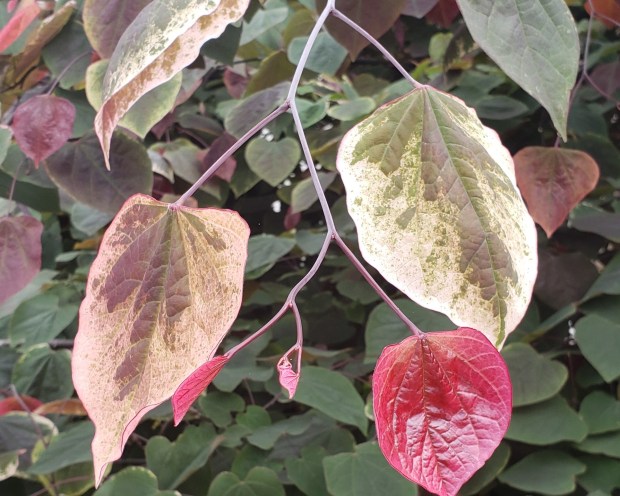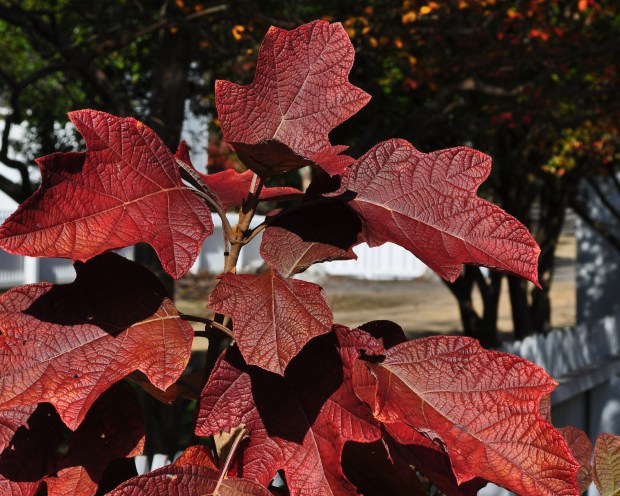Now that spring has passed and coastal Virginia is cloaked in summer heat, many plants have finished their yearly show of flowers. Attracting pollinators as well as the adoration of passersby, flowers provide immeasurable value to the ecosystem and the community. A plant’s foliage, however, is equally important and often underappreciated; it can be just as beautiful as the most striking flower.
Here are four trees, perennials and shrubs that have lovely foliage and do well in this region.
With its colorful buds and spring blooming flowers, Eastern redbud (Cercis canadensis) is one of our showiest native trees. While the heart-shaped leaves are not unattractive, they will blend into the background with all the other green foliage. However, plant breeders have been busy giving gardeners even more reasons to plant redbuds. There are now selections with burgundy foliage like Merlot or Ruby Falls. If you prefer something variegated, look for Carolina Sweetheart or Alley Cat. One of the more unusual varieties is Sunrise, whose leaves start off a dark orange, change to yellow, and by summer are a bright chartreuse.
 Many varieties of Eastern redbud with outstanding foliage have been introduced in the past few decades, like this Carolina Sweetheart. (Les Parks)
Many varieties of Eastern redbud with outstanding foliage have been introduced in the past few decades, like this Carolina Sweetheart. (Les Parks)
Closer to the ground this time of year, it is possible to see the blooms of spotted beebalm (Monarda punctata). From April to September, it displays tubular yellow flowers with purple spots. Supporting these smaller flowers are distinctive, much showier, bracts. Bracts are modified leaves that typically surround the flowers and are often much more striking than the flowers themselves. In spotted beebalm, these bracts are pale purple or pink, often fading gracefully to white or green. The foliage isn’t just beautiful, it’s also aromatic, with the fragrance of “fine Greek oregano,” as the Lady Bird Johnson Wildflower Center has observed.
 Arkansas blue star is rare in its native environment, but it is now common in local landscapes, where its foliage can be appreciated. (Perry Mathewes)
Arkansas blue star is rare in its native environment, but it is now common in local landscapes, where its foliage can be appreciated. (Perry Mathewes)
While July is too late to admire the star-shaped pale blue flowers of Arkansas blue star (Amsonia hubrichtii), the real star of the show is its foliage. Somewhat resembling a delicate fern, this tough, drought tolerant North American native will add wonderful texture to the summer garden. Then in fall, it turns a beautiful golden yellow, becoming one of the best perennials for fall color. Interestingly, the genus name Amsonia honors the 18th-century Williamsburg physician and botanist John Amson.
 Most hydrangea species have pretty lackluster fall foliage. Not so with oakleaf hydrangea. (Les Parks)
Most hydrangea species have pretty lackluster fall foliage. Not so with oakleaf hydrangea. (Les Parks)
Trees and herbaceous perennials are not the only plants with unusual foliage. Many shrubs display leaves with interesting textures and shapes as well. Oakleaf hydrangea (Hydrangea quercifolia) is a Gulf states native flowering shrub that has something to offer in every season. Although its large flower clusters are very attractive as they morph from spring white to summer dusty pink and finally to a fall straw color, the foliage is just as spectacular. Its handsome leaves do resemble those of an oak. Unlike most hydrangeas, this one puts on a fantastic display of fall color when those leaves turn shades of burgundy and burnt orange. Once you recover from that display, you can enjoy the quiet beauty of winter with this hydrangea’s exfoliating, cinnamon colored bark.
And even when leaves are not as showy or unusual as these, they can still be appreciated for the beauty shown through their venation, shape, arrangement, color and texture.
Wild Green Yonder is a recurring monthly feature by the staff of the Norfolk Botanical Garden, where Jake Litchfield is a horticulturist. Send gardening questions to askaplantquestion@nbgs.org.

